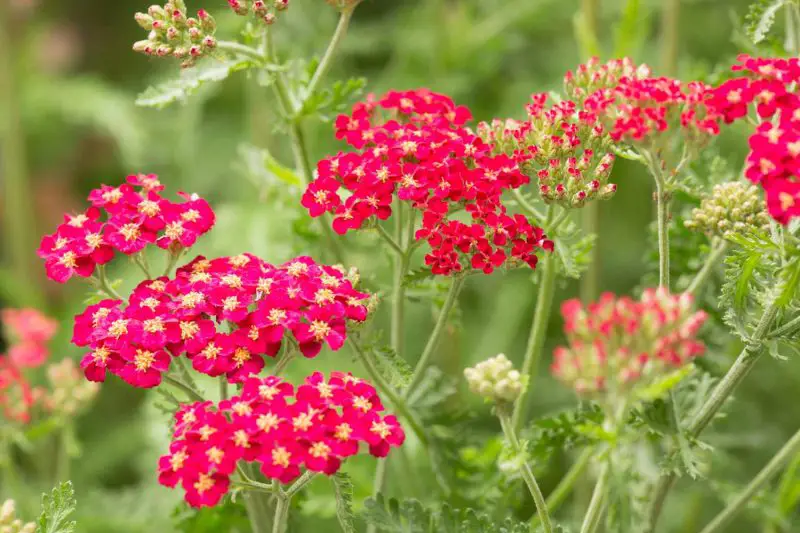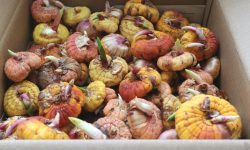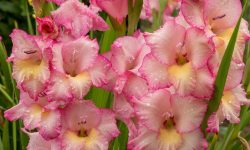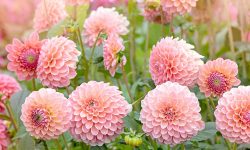Yarrow is a hardy perennial herb celebrated for its feathery foliage and clusters of vibrant flowers that bloom throughout the summer. Known scientifically as Achillea millefolium, this plant is not only admired for its ornamental value but also cherished for its medicinal and ecological benefits. Gardeners often choose yarrow for its ability to attract pollinators and its resilience in various growing conditions. With the right care and thoughtful planting, yarrow can become a standout feature in any garden.
The plant’s adaptability makes it an ideal choice for beginners and experienced gardeners alike. Yarrow thrives in a wide range of soils and is remarkably drought tolerant once established. This ability to endure less-than-ideal conditions means it can flourish in gardens where other plants may struggle. Because of this, many gardeners use yarrow to add reliable, long-lasting color to flower beds, borders, and wildflower meadows.
Understanding Yarrow’s Growing Requirements

To grow yarrow successfully, it is important to first understand its natural growing preferences. This perennial plant is native to temperate regions and commonly found in meadows, grasslands, and open woodlands. It is naturally adapted to sunny environments and thrives in conditions that replicate its native habitat. Knowing its needs for sunlight, soil type, and water will help set the foundation for healthy plants.
Yarrow grows best in full sun where it receives at least six hours of direct light daily. In shaded locations, the plant may become leggy and produce fewer flowers. Soil conditions are equally important. Yarrow prefers well-drained soil and does not tolerate waterlogged conditions. Sandy or loamy soil with moderate fertility is ideal, as overly rich soil can cause excessive foliage growth with fewer blooms.
Another factor to consider is water management. While young plants require consistent moisture to establish strong roots, mature yarrow is highly drought tolerant. Once the root system is established, it thrives with minimal watering, making it a sustainable choice for low-maintenance landscapes. These natural adaptations allow gardeners to enjoy abundant color without constant attention.
Choosing the Right Variety of Yarrow
Yarrow comes in a wide range of cultivars, each offering unique flower colors and growth habits. Selecting the right variety ensures your garden design goals are met while providing the resilience and beauty associated with this plant. Some varieties are compact and suitable for borders, while others grow taller and are perfect for creating naturalized landscapes.
Common yarrow (Achillea millefolium) produces classic white flower clusters and is known for its medicinal qualities. Hybrid cultivars, however, offer shades of pink, yellow, red, and even orange, adding variety to your garden palette. Popular options like ‘Paprika,’ with its deep red blooms, or ‘Moonshine,’ with bright yellow flowers, provide long-lasting color through the summer months. Choosing cultivars based on flower color and plant height helps achieve the desired garden effect.
It is also worth considering the climate adaptability of each cultivar. Some hybrids are bred for heat tolerance, while others are better suited to cooler regions. By researching different varieties, gardeners can select plants that not only suit their aesthetic preferences but also thrive in their specific growing conditions. A thoughtful choice of yarrow variety ensures lasting blooms and minimal maintenance.
Preparing Soil for Planting Yarrow
Healthy soil is the cornerstone of thriving yarrow plants. While this perennial is known for its ability to adapt, preparing the soil before planting will enhance growth and flowering. Yarrow prefers soil with good drainage, as waterlogged conditions can lead to root rot and fungal diseases. Loamy or sandy soil types are particularly well-suited for this resilient plant.
Before planting, it is beneficial to loosen the soil and remove weeds or debris that may compete for nutrients. Incorporating organic matter such as compost can improve soil texture without making it excessively fertile. Too much fertility can encourage lush foliage growth at the expense of flowers. For this reason, moderate soil improvement is best when preparing the planting site.
Soil pH is another factor to consider. Yarrow thrives in slightly acidic to neutral soils with a pH range of 6.0 to 7.0. Testing soil before planting provides a clear understanding of its condition, allowing adjustments if necessary. With well-prepared soil that balances drainage, fertility, and pH, gardeners create an environment where yarrow can establish strong roots and bloom abundantly.
Planting Yarrow in the Garden
Planting yarrow correctly sets the stage for years of vibrant blooms. The process begins with selecting a sunny location that offers at least six hours of direct light daily. Once the site is chosen, spacing plants appropriately is essential. Yarrow can spread quickly, so providing 12 to 24 inches of space between plants ensures proper air circulation and prevents overcrowding.
Transplanting nursery-grown plants is the most common method for establishing yarrow in gardens. Dig a hole slightly larger than the root ball, place the plant, and gently backfill with soil. Firm the soil lightly around the base to eliminate air pockets and water thoroughly after planting. This initial watering helps roots settle into their new environment.
For those who prefer starting from seed, sowing directly into the garden is also an option. Seeds should be lightly pressed into the soil surface, as they require light to germinate. Whether planting transplants or seeds, consistent moisture during the establishment phase ensures strong root development. Once established, yarrow requires minimal care and quickly adapts to its surroundings.
Watering Yarrow Effectively
Proper watering is crucial for establishing healthy yarrow plants, especially during their early growth stages. Newly planted yarrow requires consistent moisture to develop strong root systems. During the first few weeks, keeping the soil evenly moist helps plants adapt to their new environment and encourages robust growth.
As yarrow matures, its water requirements decrease significantly. This plant is naturally drought tolerant and performs best when watered sparingly. Overwatering can lead to weak growth, fungal problems, and root rot. Mature yarrow should be watered only during extended dry spells, making it an excellent choice for low-maintenance or water-wise gardens.
Mulching around the base of plants can help retain soil moisture and reduce the frequency of watering. However, mulch should be applied carefully to avoid covering the crown of the plant. By adjusting watering practices based on plant maturity and climate conditions, gardeners can keep yarrow thriving without excessive effort.
Fertilizing Yarrow for Strong Growth
Yarrow is not a heavy feeder, but balanced fertilization can support strong growth and vibrant blooms. Excessive nutrients, particularly nitrogen, encourage foliage growth at the expense of flowers. Therefore, it is best to use a low-nitrogen fertilizer that promotes flowering without overstimulating leafy development.
Applying compost or a slow-release organic fertilizer in early spring is usually sufficient for the season. This provides the plant with the nutrients needed for active growth and flower production. Additional feeding during midsummer can benefit long-blooming cultivars, especially if soil fertility is naturally low.
When applying fertilizer, it is important to follow recommended dosages. Over-fertilization not only reduces flowering but can also stress the plant and make it more susceptible to disease. With modest, well-timed applications, yarrow receives the nutrients it needs to maintain healthy foliage and abundant flowers throughout the growing season.
Pruning and Deadheading Yarrow
Regular pruning and deadheading play an important role in maintaining the beauty and health of yarrow plants. Deadheading, or removing spent flower heads, encourages the plant to produce new blooms. This practice extends the flowering period and prevents the plant from directing energy toward seed production instead of new flowers.
To deadhead, cut the flower stems back to the nearest set of healthy leaves. This not only improves the plant’s appearance but also stimulates fresh growth. In addition to deadheading, pruning back yarrow in late fall or early spring helps rejuvenate the plant. Cutting stems down to a few inches above the ground prepares it for vigorous regrowth.
Pruning also controls the spread of yarrow, which can be aggressive in some gardens. By managing growth and encouraging continuous flowering, gardeners can enjoy lush, colorful displays throughout the season. Proper maintenance ensures yarrow remains a highlight in the landscape year after year.
Propagating Yarrow for More Plants
Propagation is an excellent way to expand your yarrow collection or share plants with others. The most common propagation methods are division, cuttings, and seeds. Division is often the easiest and most effective method, especially for maintaining plant vigor. Mature clumps can be divided every two to three years in early spring or fall.
Cuttings are another reliable method. Softwood cuttings taken in late spring can be rooted in a well-draining potting mix. With proper care, they develop into new plants that carry the same characteristics as the parent variety. This method is particularly useful for propagating hybrids that may not grow true from seed.
Growing yarrow from seed provides another option, though it requires patience. Seeds should be sown on the soil surface indoors or outdoors, as they need light to germinate. Regardless of the method chosen, propagation allows gardeners to enjoy more yarrow plants and create larger, more colorful displays in their gardens.
Controlling Yarrow’s Spread
Yarrow is a resilient perennial that thrives in many types of soil and climates, but its vigorous nature means it can spread more quickly than expected. The plant’s rhizomatous roots allow it to form dense clumps that easily colonize open spaces. While this growth habit can be beneficial for covering bare ground, it also poses challenges for gardeners who want to maintain balance in their landscapes. Without management, yarrow may encroach on areas reserved for other plants, limiting diversity and design control in the garden.
To prevent yarrow from taking over, regular maintenance is key. One of the most effective strategies is dividing the plants every two to three years. This not only keeps their spread in check but also rejuvenates older clumps, encouraging stronger growth and better flowering. Another method is edging or creating barriers in the soil to confine roots to a designated space. These physical boundaries help contain the plant while still allowing it to thrive in its intended area. Consistent deadheading after blooms fade also reduces self-seeding, further limiting its potential spread.
In addition to physical control, thoughtful garden planning plays a role in managing yarrow’s growth. Placing it in a contained bed, alongside other vigorous perennials, or using it in areas where groundcover is desirable can turn its spreading habit into an advantage. By choosing the right location and applying simple maintenance routines, gardeners can enjoy yarrow’s long-lasting beauty without worrying about it overwhelming their landscape. The balance lies in embracing its natural vigor while guiding it to fit within the overall garden design.
Yarrow in Companion Planting
Yarrow has long been valued as a companion plant because of its ability to improve soil health and support other plants. Its deep roots help break up compacted soil, increasing aeration and allowing water to penetrate more effectively. This quality makes it an excellent neighbor for vegetables and flowers that prefer well-drained conditions. Additionally, yarrow’s foliage contains compounds that can enrich surrounding soil when decomposed, contributing to overall garden fertility. By including it in mixed plantings, gardeners create an environment where many species thrive together.
Beyond soil improvement, yarrow attracts beneficial insects that play a crucial role in natural pest control. Predatory insects like ladybugs, lacewings, and hoverflies are drawn to its clusters of tiny flowers, where they feed on nectar before preying on harmful pests such as aphids. This creates a balanced ecosystem in the garden, reducing the need for chemical sprays and fostering healthier growth for companion plants. Yarrow’s presence can also increase pollinator activity, which benefits nearby crops that rely on bees and butterflies for fruit and seed production.
Another advantage of yarrow in companion planting is its resilience and adaptability. It can serve as a natural border or filler in vegetable gardens, herb beds, and ornamental landscapes, providing beauty while supporting productivity. When placed strategically, yarrow not only enhances the visual appeal of the garden but also creates a sustainable growing system. Its ability to strengthen plant communities makes it a valuable addition for gardeners seeking to combine function with aesthetics in their outdoor spaces.
Medicinal and Herbal Uses of Yarrow
Yarrow has been treasured for centuries in traditional medicine due to its wide range of healing properties. Ancient civilizations, including the Greeks and Native Americans, used it to treat wounds, reduce inflammation, and ease digestive discomfort. Its common nickname, “soldier’s herb,” reflects its long-standing reputation as a natural remedy for stopping bleeding and promoting faster healing. Today, many herbalists still value yarrow as an accessible and effective plant for home remedies.
In modern herbal practices, yarrow is commonly brewed into teas or tinctures to support wellness. Yarrow tea is believed to help with colds and fevers by promoting perspiration, which may aid in lowering body temperature. The plant also contains compounds that are thought to relax muscles and improve circulation, making it useful for menstrual discomfort and mild digestive issues. While more scientific studies are needed, its continued use demonstrates the enduring trust people place in its natural benefits.
Beyond its internal uses, yarrow is often incorporated into topical treatments. Salves and compresses made from its leaves and flowers are applied to cuts, bruises, or skin irritations to soothe and support recovery. The plant’s essential oils are sometimes used in aromatherapy, where their calming scent contributes to stress relief. Whether employed in teas, ointments, or oils, yarrow offers versatile herbal applications that connect modern gardeners with ancient traditions, highlighting the plant’s role as both an ornamental and a healing ally.
Yarrow for Pollinators and Wildlife
Yarrow plays an important role in supporting pollinators, making it a valuable addition to any wildlife-friendly garden. Its broad, flat flower clusters provide an easy landing platform for bees, butterflies, and other beneficial insects. The plant produces nectar and pollen consistently throughout its blooming season, offering a reliable food source when other flowers may be scarce. This steady supply helps sustain pollinator populations, which in turn benefits surrounding plants that rely on cross-pollination for reproduction.
In addition to insects, yarrow also attracts other forms of wildlife that contribute to garden health. Birds may visit yarrow patches to feed on insects that gather around its blooms, while small mammals benefit indirectly from the healthier ecosystems created by pollinator activity. By fostering biodiversity, yarrow enhances the resilience of the garden environment, making it more balanced and self-sustaining. Its adaptability to various climates further increases its value as a dependable resource for wildlife across regions.
Yarrow’s ability to blend ornamental beauty with ecological function makes it especially appealing for gardeners who want to create thriving habitats. By planting yarrow, gardeners not only add vibrant color and texture to their landscapes but also actively contribute to pollinator conservation. Whether incorporated into wildflower meadows, pollinator pathways, or backyard borders, yarrow provides a bridge between cultivated spaces and the natural world, enriching both human enjoyment and ecological health.
Overwintering Yarrow Successfully
One of the reasons yarrow is so popular among gardeners is its impressive hardiness, but providing the right winter care ensures it comes back strong each spring. In colder climates, yarrow naturally goes dormant, with its foliage dying back to the ground as temperatures drop. Cutting back the stems after the first frost helps tidy the garden and prevents disease from overwintering in decaying plant matter. A light mulch layer can also be applied to protect the roots from extreme cold and fluctuations in soil temperature.
In regions with mild winters, yarrow often retains some green growth year-round, requiring less maintenance. However, trimming back leggy or damaged foliage keeps the plant looking neat and encourages fresh shoots when spring arrives. Monitoring soil moisture is equally important during the colder months, as excessive water can lead to root rot. While yarrow tolerates drought well, winter rains or snowmelt in poorly drained soil can create unfavorable conditions that weaken the plant.
For gardeners who grow yarrow in containers, overwintering requires extra attention. Pots should be moved to sheltered locations, such as unheated garages or patios protected from harsh winds. Insulating the containers with straw or burlap helps prevent root damage caused by freezing temperatures. By tailoring winter care practices to local conditions, gardeners can ensure that yarrow not only survives the cold months but also thrives with renewed vigor when the growing season returns.
Common Mistakes to Avoid and How to Solve
Overwatering Yarrow
Overwatering is one of the easiest mistakes to make with yarrow, especially for beginners who assume all perennials need constant moisture. Unlike many plants, yarrow thrives in moderately dry soil and can tolerate drought conditions very well. When watered too often, the roots may become waterlogged, leading to diseases such as root rot and powdery mildew. This not only weakens the plant but can also shorten its lifespan and reduce blooming potential.
To solve this, always check the soil before watering. If the top inch feels dry, a deep soak is enough to sustain the plant for days. Amending heavy soil with sand, gravel, or compost improves drainage and keeps excess water away from roots. Avoid daily watering routines and instead focus on less frequent but deeper watering sessions. With proper attention, yarrow will grow stronger, healthier, and more abundant in flowers.
Allowing Yarrow to Spread Uncontrolled
Another frequent issue is letting yarrow spread unchecked, which can quickly turn this beneficial perennial into an invasive problem. Yarrow spreads both through underground rhizomes and by self-seeding, allowing it to dominate planting beds in just a few seasons. Its dense clumps often outcompete slower-growing plants, taking up valuable space, light, and nutrients. While its vigor can be helpful for covering bare soil and preventing erosion, without careful management, it may smother more delicate perennials and disrupt the balance of a thoughtfully designed garden. Gardeners who value diversity may soon find yarrow overwhelming other plants, reducing the variety and visual appeal of their landscapes.
The best way to control spreading is to divide yarrow clumps every two to three years, a simple practice that maintains its size and ensures healthier growth. Division also provides opportunities to replant in new areas or share with fellow gardeners. Deadheading flowers before seeds mature prevents uncontrolled reseeding and keeps the plant tidy. Installing physical barriers such as edging, raised beds, or containers helps keep rhizomes contained, offering greater control. By taking these proactive steps, yarrow remains an asset—adding color, texture, and ecological benefits—without becoming a nuisance or overpowering the garden’s harmony.
Neglecting Seasonal Care
Many gardeners overlook seasonal care, assuming yarrow can thrive without attention year-round. While it is hardy and adaptable, neglecting to trim dead stalks, remove spent flowers, or prepare the plant for winter often reduces its long-term performance. Over time, untrimmed plants can look messy, attract pests, and harbor fungal diseases in decaying foliage. Skipping these seasonal steps not only affects yarrow’s appearance but also leads to weaker regrowth in spring and fewer blooms during the peak growing season.
The solution is consistent and mindful maintenance that follows the plant’s natural rhythm. Deadhead blooms throughout summer to prolong flowering and keep the plant tidy. In late fall, cut stems back to a few inches above ground to encourage strong dormancy and reduce the spread of disease. Applying mulch protects roots during freezing temperatures and ensures stability in fluctuating weather. Come spring, removing mulch and cleaning around the base allows healthy shoots to emerge quickly. These small, thoughtful tasks take little time yet greatly enhance the plant’s resilience, ensuring yarrow rewards you with lush foliage and vibrant flowers year after year.
Planting in Poorly Drained Soil
One of the most common mistakes when growing yarrow is planting it in soil that retains too much moisture. While yarrow is tolerant of many conditions, heavy clay or compacted soils create an environment where roots can rot. Constantly wet soil also encourages fungal problems, which weaken the plant and limit its blooming capacity. Even though yarrow is hardy, it does not adapt well to waterlogged conditions.
To solve this, ensure the soil drains efficiently by amending it with sand, gravel, or compost before planting. Raised beds or mounds can also improve drainage in areas with naturally heavy soils. Once established in the right soil, yarrow thrives with minimal watering and produces healthier, longer-lasting blooms. Proper soil preparation is a key step to avoiding future struggles.
Growing Yarrow in Too Much Shade
Another frequent error is placing yarrow in areas that do not receive enough sunlight. While it can tolerate partial shade, yarrow performs best in full sun for at least six hours daily. When planted in shaded areas, it often grows leggy, produces fewer flowers, and becomes more prone to disease. Limited sunlight also reduces the plant’s overall vigor, making it less appealing in the garden. Without sufficient light, the stems may become weak, causing the plant to flop over and lose its natural upright form, which diminishes its ornamental value.
The solution is to choose a sunny location where yarrow can flourish. If full sun is not possible, select the brightest spot available and avoid areas blocked by large trees or structures. Regularly monitor the site to ensure that seasonal changes, such as tree growth or shifting shade patterns, do not reduce sunlight exposure. In sunnier conditions, yarrow will produce stronger stems, more abundant blooms, and show its true potential as a resilient and vibrant perennial, rewarding gardeners with reliable beauty year after year.
Fertilizer Mistakes
Another common mistake when growing yarrow is overfertilizing. Many gardeners assume that adding more nutrients will lead to stronger plants and brighter flowers. However, yarrow naturally thrives in poor to moderately fertile soils, and excessive fertilizer—especially high-nitrogen types—encourages leafy growth instead of blooms. This can result in tall, floppy stems and a reduction in flower production, diminishing the plant’s decorative appeal. Overfertilizing may also disrupt the soil balance, making the plant more vulnerable to pests and diseases over time.
The solution is to limit fertilizer use and rely on yarrow’s natural hardiness. In most cases, yarrow does not require supplemental feeding, especially if the soil is reasonably healthy. If growth seems weak, a light application of a balanced, slow-release fertilizer in spring is sufficient. Alternatively, enriching the soil with compost once a year provides all the nutrients yarrow needs. By avoiding overfertilization, gardeners can maintain compact plants with abundant blooms while preserving the plant’s natural resilience and charm.
FAQ about Growing Yarrow
How often should I water yarrow?
Yarrow prefers moderately dry soil and does not require frequent watering once established. Deep watering every 10–14 days is usually enough, especially in hot weather. Overwatering can cause root rot, so ensure the soil drains well and allow the top layer to dry between waterings.
Can yarrow grow in poor soil conditions?
Yes, yarrow is highly adaptable and often thrives in poor, sandy, or rocky soils where other plants struggle. Its deep roots help it access nutrients and moisture. While it does not need rich soil, ensuring proper drainage is essential to prevent problems with disease or overgrowth.
Does yarrow come back every year?
Yarrow is a hardy perennial, meaning it comes back year after year once established. In colder climates, it dies back in winter but regrows vigorously in spring. With proper care, dividing clumps every few years, and protecting roots in severe winters, it remains a reliable garden plant.
How do I keep yarrow from spreading too much?
Yarrow spreads quickly through rhizomes and self-seeding. To control it, divide the clumps every two to three years, deadhead faded flowers before seeds form, and plant it in designated spaces. Installing garden edging or barriers around the planting area also helps prevent unwanted spreading.
Is yarrow safe to use as a medicinal herb?
Yarrow has a long history in herbal medicine, used for teas, salves, and tinctures. It may support wound healing, circulation, and digestion. However, it should be used cautiously, as some people may develop allergic reactions. Always consult a qualified herbalist or healthcare provider before internal use.
Conclusion
Yarrow is more than just a garden flower—it is a symbol of resilience, healing, and natural beauty. With its clusters of bright blooms, ability to attract pollinators, and centuries-old role in herbal traditions, yarrow enriches both the landscape and the gardener’s experience. Its adaptability allows it to thrive in diverse conditions, bringing lasting color and life to any space. By learning how to nurture, control, and appreciate this remarkable plant, you can enjoy its many gifts season after season. Growing yarrow is not simply about adding another perennial to your garden—it is about creating a vibrant, balanced, and meaningful connection with nature that endures year after year.






